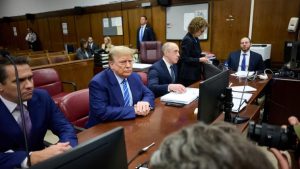US stock futures slid and sovereign bonds surged on Friday as investors feared President Donald Trump’s shock move to slap tariffs on Mexico risked tipping the United States, and maybe the whole world, into recession.
The outlook darkened further when a key measure of Chinese manufacturing activity disappointed for May, questioning the effectiveness of Beijing’s stimulus steps.
Markets moved aggressively to price in deeper rate cuts by the Federal Reserve this year, while bond yields touched fresh lows and curves inverted in a warning of recession.
Washington will impose a 5% tariff from June 10, which would then rise steadily to 25% until illegal immigration across the southern border was stopped.
Trump announced the decision on Twitter late Thursday, catching markets completely by surprise and sparking a rush to safe harbours.
“The threat of US tariffs on Mexico to take effect inside two weeks is a sharp blow to investor sentiment,” said Sean Callow, a senior FX analyst at Westpac.
“Mexico is the US’s largest trading partner and a flare-up in trade tensions was definitely not on the market radar,” he added. “This is obviously a major setback for CAD, MXN and the thousands of US businesses that use Mexican-made products.”
Yields on the 10-year Treasury note quickly fell to a fresh 20-month low of 2.18%, while the dollar jumped 1.7%on the Mexican peso. E-Mini futures for the S&P 500slipped 0.7% and FTSE futures 0.4%.
Asian shares slid at first but soon drew month-end bargain hunting having suffered a torrid few weeks. MSCI’s broadest index of Asia-Pacific shares outside Japan edged up 0.3%, though it was still down 7.3% for the month.
China’s blue chip index added 0.7%, partly on talk Beijing would now have to ramp up its stimulus measures.
Japan’s Nikkei pared early losses to be off 0.6%, but was still down 6.5% for the month so far.
Investors clearly feared that opening a new front in the trade wars would threaten global and U.S. growth, and pressure central banks everywhere to consider new stimulus.
On Thursday, Federal Reserve Board of Governors Vice Chair Richard Clarida had said the central bank would act if inflation stays too low or global and financial risks endanger the economic outlook.
“What the Clarida’s comments have done is clarify in many people’s minds the answer to the questions of whether low inflation proving more than transitory would itself be enough to get the Fed to ease — the answer appears to be ‘yes’,” said Ray Attrill, head of FX strategy at National Australia Bank.
“That served to reinforce prevailing market expectations that the Fed will be easing in the second half of this year.”
Indeed, the case that the inflation slowdown was temporary took a blow when the core personal consumption expenditures index, the Fed’s favoured measure of inflation, was revised down to 1% for the first quarter, from 1.3%.
Trump’s tariff threat only added to the dangers and the market further narrowed the odds on Fed easing this year and next. Futures imply 44 basis points of cuts by year end in the current effective funds rate of 2.38%.





